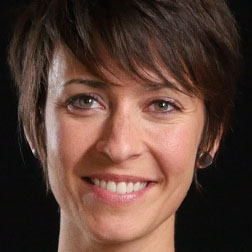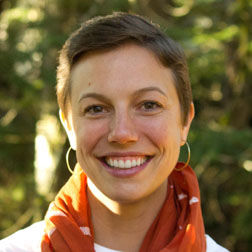In my experience, any time we engage in a conversation about our differences with an intention to prove the other side wrong, we’re heading for a dead end. When we take a right-wrong stance to any conversation about difference — whether it’s about race or gender, politics or religion — it reveals that we’re more interested in affirming our positions (and our sense of self tied to those positions) than anything else.
Engaging this way also rests on a hidden belief: that the tension between our differences can be fixed. Even if by some miracle – by simply pointing out why “my” difference is right and “yours” is wrong – I do convert you to my side, this at best creates a false harmony. False, because it keeps our psyches untouched, our perspectives unchanged, and our ways of being with one another limited. The only real victory in this case is a shallow truce that avoids a greater complexity and, ultimately, a greater intimacy, in favor of a more complacent sense of safety.
As a facilitator, I’m interested in working with groups that are keen on developing themselves. I’ve found that one of the most essential ways we can foster growth is through engaging our differences. Consciously engaging our differences is transformational for our ability to learn and grow through relationships.
As I experiment with different ways to support curious, keen-to-grow groups, I’ve come to rely on some basic orienting frames for engaging differences in a way that has the greatest transformational impact.
First, we have to take the position that our differences are fundamentally irresolvable. There is nothing to solve, nothing to fix in our differences. When we realize that we literally cannot get rid of our differences (at best we can marginalize them from our awareness, at worst, attempt to exterminate them, i.e. genocide) — we get to drop much of our underlying anxiety that somehow, things aren’t okay if we are different.
Second, we embrace the view that we are in a growth process for our entire lives. The best studies on human development show clearly that adults grow and develop new capacities cognitively, emotionally, morally — even existentially — indefinitely. When we embrace this idea, our life’s challenges become opportunities for greater growth, not simply obstacles in our way to being comfortable.
And lastly, we make a personal commitment to allow ourselves to be grown by our differences. I think Harvard developmental psychologist and researcher Robert Kegan explains this best when he says, “…the nature of our conflict suggests not that the other side will not go away, but that it probably should not. The conflict is a likely consequence of one or both of us making prior, true, distinct, and whole our partial position. The conflict is potentially a reminder of our tendency to pretend to completeness when we are in fact incomplete. We may have this conflict because we need it to recover our truer complexity.”
For me, this commitment is precisely what it means to engage mindfulness in the midst of our differences. Almost inevitably, when we are engaged with one another and our differences lock horns we’ll become defensive and hunker down into ourselves and our positions. This response to difference has its roots in our basic primate ancestry and isn’t something we can re-wire without practice. Mindfulness is the practice of beginning to “choose out of” these defensive reactions. It frees us to become curious as to the limits of our “partial position,” and maybe even create a space for something new to grow us.
My mentor and colleague Diane Hamilton, author of Everything is Workable & co-founder of Integral Facilitator, says, “the capacity to take a perspective on our perspective is a bright line in human development.” This last commitment is all about pursuing that bright line inside ourselves.
My invitation is this: Let us be attentive the next time we enter a conflict with the intention of proving the other side wrong. Let us be suspicious of how we might be preserving our ‘self’ by holding onto our position and habitual ways of relating to others, because it is entirely possible — likely, I would say — that the purpose of the conflict isn’t to help us confirm what we already believe, but to help us discover something new.
So, let’s differ consciously with the full expectation that we will be someone else (and hopefully someone better) after our differences have had their way with us.
Gabriel Wilson
Lecturer, Stanford University
Chair, Integral Diversity Initiative
Certified Integral Facilitator®



10 thoughts on “Letting Our Differences Have Their Way With Us”
Very interested and enlightening
Thank you, Beth for your comment.
Oh???? I keep falling into this trap, always thinking my intentions are to help “correct”. Both sides lose leaving frustration and confusion. I would like to find a grounding in those moments that enables me to explore and find something new. I will try next time !
Derren, after writing this piece I’ve fallen into this trap too 🙂 Certainly ironic and undoubtedly humbling. I love your honesty (it makes you trustable in my book) and your intention to find grounding and explore something new in those moments of conflict and intensity – I’m right there with you, my friend!
Thank you Gabe – this is so clearly written and provocative. I believe that our differences are fundamentally irresolvable yet I notice in my facilitation that when differences are amplified in conflict that I’m constantly trying to facilitate the conversation to the place of the apex or collapse of the differences to a place of unity. When that begins to happen the dialogue changes. What I’m noticing as I read your blog is that under all the talking is my own belief that I just wish the conflict would go away, that we could all just understand each other and not see so much difference. On reflection I think I still bring too much of my own fear into the facilitation and that calling it “unity” is a way to hide behind that fear. I need to reflect on this more but for now this is a good kick in the pants to get more honest with myself.
Gabe, I appreciate your clarity in this article……an edge for me is coming out of my bias to resolve conflict and create harmony. I see the benefit of letting conflict change me and yet I get triggered someone close to me protects their position by making mine wrong. I fall right into mirroring their stance. I am catching it sooner………comforting that I have the rest of my life to go in this direction.
Janice, amen to a life of learning 🙂
Jane, I hear you… at the moment, the sentence that leaps out at me is the desire of “just understand(ing) each other and not see so much difference.” I intuit a orientation to myself that is not identified with a perspective (over another) – there is an Auribindo quote that I’ll paraphrase that gives words to this ‘new’ orientation: there is a mind that relates to the differences ‘out there’ as its own diversity reflected back at itself.
This, then, introduces the question of “what do I then stand for?” if I am all perspectives/positions… Thanks for the reflections, friend.
I like that…
I like the perspective that differences contribute to our collective intelligence – sort of like the blind men and the elephant story. We really have to have all perspectives or we can’t possibly know the whole truth.
Another aspect of difference I learned from Matrix Leadership that might be interesting to people is that if a group as a whole has a culture of suppressing differences, for whatever reason, conflict will start to be expressed through a “conflict pair” who seem like lightning rods with escalated energy and seemingly intractable differences. When the floor is opened up for others to express their differences more openly, that pair will experience the energy of their conflict draining down to reasonable levels. They call it, “distributing”. One simple way is to have people say, “My version of this issue is…”, or to just name other major differences without necessarily going into them in depth. The idea is that we are all a collective energy field once we form a group, whether we realize it or not, and if the energy is suppressed it finds its way out in an escalated form. Contrast this to the old model where you would just send that pair to mediation and hope they get themselves sorted out.
Emma, thanks for your comments and love you brining in the dynamic of the “conflict pair” – I’ve seen that happen a lot, and the ‘move’ to distribute the energy in the pair across others in the group. So many layers, thanks for adding this one.